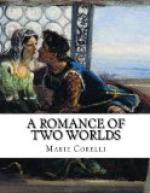“Yet surely,” I said, “the telescope has enabled us to see the Moon as a solid globe—we have discerned mountains and valleys on its surface; and then it revolves round us regularly—how do you account for these facts?”
“The telescope,” returned Heliobas, “is merely an aid to the human eye; and, as I told you before, nothing is so easily deceived as our sense of vision, even when assisted by mechanical appliances. The telescope, like the stereoscope, simply enables us to see the portrait of the Moon more clearly; but all the same, the Moon, as a world, does not exist. Her likeness, taken by electricity, may last some thousands of years, and as long as it lasts it must revolve around us, because everything in the universe moves, and moves in a circle. Besides which, this portrait of the moon being composed of pure electricity, is attracted and forced to follow the Earth by the compelling influence of the Earth’s own electric power. Therefore, till the picture fades, it must attend the Earth like the haunting spectre of a dead joy. You can understand now why we never see what we imagine to be the other side of the Moon. It simply has no other side, except space. Space is the canvas—the Moon is a sketch. How interested we are when a discovery is made of some rare old painting, of which the subject is a perfectly beautiful woman! It bears no name—perhaps no date—but the face that smiles at us is exquisite—the lips yet pout for kisses—the eyes brim over, with love! And we admire it tenderly and reverently—we mark it ’Portrait of a lady,’ and give it an honoured place among our art collections. With how much more reverence and tenderness ought we to look up at the ‘Portrait of a Fair Lost Sphere,’ circling yonder in that dense ever-moving gallery of wonders where the hurrying throng of spectators are living and dying worlds!”
I had followed the speaker’s words with fascinated attention, but now I said:
“Dying, Heliobas? There is no death.”
“True!” he answered, with hesitating slowness. “But there is what we call death—transition—and it is always a parting.”
“But not for long!” I exclaimed, with all the gladness and eagerness of my lately instructed soul. “As worlds are absorbed into the Electric Circle and again thrown out in new and more glorious forms, so are we absorbed and changed into shapes of perfect beauty, having eyes that are strong and pure enough to look God in the face. The body perishes—but what have we to do with the body—our prison and place of experience, except to rejoice when we shake off its weight for ever!”
Heliobas smiled gravely.
“You have learned your high lesson well,” he said. “You speak with the assurance and delight of a spirit satisfied. But when I talk of death, I mean by that word the parting asunder of two souls who love each other; and though such separation may be brief, still it is always a separation. For instance, suppose—” he hesitated: “suppose Zara were to die?”




